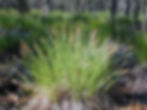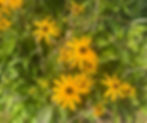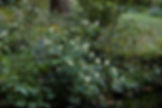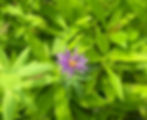Top Companion Plants for Asclepias incarnata (Swamp Milkweed)
- Devin
- Apr 10
- 10 min read
Updated: Apr 11
Imagine strolling through your garden on a warm summer morning. The dew still clings to the leaves, the air is thick with the scent of wildflowers, and bees are already busy at work. In the center of it all stands your Asclepias incarnata—Swamp Milkweed—tall and proud, its clusters of soft pink blossoms gently nodding in the breeze. It’s a moment of peace, of harmony. But what you might not see at first glance is that Swamp Milkweed doesn’t thrive on its own. Like any strong performer, it shines best with a solid supporting cast.
In nature, plants are never alone. They grow in communities, forming relationships with other species that help them survive—and thrive. This natural teamwork is what gardeners call companion planting. And when it comes to Swamp Milkweed, choosing the right companions can make all the difference—not just for aesthetics, but for supporting butterflies, bees, and a whole orchestra of beneficial insects.
So, how do you build the perfect stage for this pollinator favorite? You start by choosing native plants that play well with others, ones that match Swamp Milkweed’s love of damp roots and open skies, and amplify its strengths instead of competing for the spotlight.

In this blog, we’re uncovering the top companion plants for Asclepias incarnata—a handpicked list of garden allies that will bring out its best, while creating a vibrant, biodiverse, and low-maintenance ecosystem right in your own backyard.
Native Gardening with Asclepias incarnata
Before we jump into choosing the perfect companions for your Swamp Milkweed, it’s important to understand what makes Asclepias incarnata such a garden hero. More than just another pretty native perennial, this plant is a bridge between beauty and biodiversity—a vital link in the chain that connects us to the natural world around us.
Light Requirements

Source: Birds&Blooms - Does Swamp Milkweed Need Full Sun to Grow?
Swamp Milkweed absolutely thrives in full sun, basking in six or more hours of direct sunlight per day. While it can tolerate some light shade, too much darkness will reduce blooming and weaken its upright structure. If you want those vibrant pink blooms to put on a summer show, give it a spot that gets plenty of sunshine.
Soil Preferences

Source: Better Homes and Gardens - What to Know About Well-Drained Soil and Boosting Plant Drainage
Don’t let the name fool you—Swamp Milkweed doesn’t need to be knee-deep in a bog to be happy. What it does need is consistently moist soil, especially during its early growth. It thrives in:
Rain gardens
Low areas with poor drainage
Edges of ponds or streams
Regular garden beds with supplemental water
Its deep taproot allows it to survive in wetter soils where many plants would rot, but it also helps it adapt to more typical garden settings, provided it doesn’t dry out completely.
Watering Needs
Once established, Swamp Milkweed is relatively low-maintenance—but don’t neglect watering during that first year. Keep the soil moist but not soggy. If you’re planting in an area that naturally holds moisture, Mother Nature will do most of the work. In drier gardens, a layer of mulch can help retain soil moisture and keep roots happy.
Bloom Time & Appearance

Source: The Old Dairy Nursery & Gardens - Asclepias incarnata | swamp milkweed
Expect blooms in mid-to-late summer, typically July through August. The soft pink to mauve flowers are a favorite of monarch butterflies, native bees, and even hummingbirds. Plus, the slender, lance-shaped leaves are a food source for monarch caterpillars.
Mature Size
Asclepias incarnata typically grows to 3–5 feet tall and spreads about 2–3 feet wide. It stands tall without being unruly and blends beautifully into naturalistic plantings.
USDA Hardiness Zone

This wide range makes Swamp Milkweed incredibly versatile across much of the United States and parts of southern Canada. Here's a quick breakdown:
Zone 3: Survives harsh winters with lows as cold as -40°F (-40°C)
Zone 9: Tolerates warmer climates with winter lows around 20–30°F (-6 to -1°C)
If you live in one of these zones, Asclepias incarnata can be grown as a hardy perennial, meaning it will return year after year after going dormant in winter. It’s especially valuable in northern regions where many other native milkweeds (like Asclepias curassavica, which is tropical) can’t survive the cold.
Learn more about USDA Hardiness Zones
Gardening with native plants like Asclepias incarnata is about more than aesthetics. It's about reconnection—with the land, with pollinators, and with the rhythms of nature. And when you thoughtfully pair this graceful, pollinator-rich milkweed with its ideal companions, you're not just planting a flower bed. You're building a habitat, creating space where life can flourish in harmony.
Stay tuned for the next section where we reveal the top companion plants for Asclepias incarnata—each one chosen to elevate your garden and amplify the magic.
Top Companion Plants for Asclepias incarnata
Creating a thriving plant community around Swamp Milkweed isn't just good gardening—it's a gift to the ecosystem. These native plants match its moisture and light needs, extend bloom times for pollinators, and add layers of texture and color to your garden. Let’s dig into the best of the best:
Eupatorium maculatum (Spotted Joe-Pye Weed)

Source: Blue Thumb - Eupatorium maculatum
Height: 4–6 feet
Bloom Time: Mid to late summer
Sun/Soil: Full sun to part shade, moist to wet soil
Pollinator Perks: A butterfly beacon, especially for swallowtails and skippers
Why it pairs well? Joe-Pye Weed blooms around the same time as Swamp Milkweed and loves similar moist conditions. Its towering pink-lavender plumes create a layered backdrop, enhancing visual depth and providing continuous nectar flow for pollinators.
Iris versicolor (Blue Flag Iris)

Height: 2–3 feet
Bloom Time: Late spring to early summer
Sun/Soil: Full sun to part shade, wet soil
Pollinator Perks: Attracts hummingbirds and bumblebees
Why it pairs well: Blooming earlier than Asclepias incarnata, Blue Flag Iris sets the stage for a season-long floral display. Its strappy leaves and elegant purple blooms pair well with the upright form of milkweed in wet areas.
Carex stricta (Tussock Sedge)

Height: 2–3 feet
Form: Grass-like clumping sedge
Sun/Soil: Full to part sun, consistently moist soil
Pollinator Perks: Host plant for skipper butterfly caterpillars
Why it pairs well: This lush, fountain-like sedge adds texture and groundcover benefits to wet gardens. It stabilizes soil, reduces erosion, and frames flowering plants like Swamp Milkweed beautifully—especially in naturalized areas.
Lobelia siphilitica (Great Blue Lobelia)

Height: 2–4 feet
Bloom Time: Late summer to early fall
Sun/Soil: Part sun to full sun, wet soil
Pollinator Perks: A magnet for bumblebees
Why it pairs well: The deep blue spikes of this lobelia are a striking contrast to the pink of Asclepias incarnata. Both thrive in damp soils, making this duo ideal for rain gardens or wetland edges.
Senna hebecarpa (Wild Senna)

Height: 3–6 feet
Bloom Time: Mid-summer
Sun/Soil: Full sun, moist to average soil
Pollinator Perks: Loved by native bees; host plant for Sulphur butterflies
Why it pairs well: Wild Senna adds a fine-textured, feathery foliage to your planting palette and creates a bold vertical statement. Its yellow flowers bloom in sync with Swamp Milkweed, boosting mid-season visual interest.
Vernonia noveboracensis (New York Ironweed)

Height: 4–7 feet
Bloom Time: Late summer to early fall
Sun/Soil: Full sun, moist to average soil
Pollinator Perks: Beloved by monarchs, bees, and native wasps
Why it pairs well: With its bold purple blooms and towering presence, New York Ironweed brings a dramatic vertical element to any pollinator garden. It blooms slightly later than Asclepias incarnata, extending nectar availability well into fall. The two share a love of moist soils and open spaces, and when planted together, they create a magnet for migrating monarchs.
Rudbeckia fulgida (Orange Coneflower)

Height: 2–3 feet
Bloom Time: Late summer in
to fall
Sun/Soil: Full sun, average to moist soil
Pollinator Perks: Attracts bees, butterflies, and seed-eating birds
Why it pairs well: These golden-yellow blooms extend your garden’s color palette
and blooming period. As Swamp Milkweed fades, Rudbeckia steps in, keeping the pollinator buffet open and the color show rolling into autumn.
Filipendula rubra (Queen of the Prairie)

Height: 4–6 feet
Bloom Time: Midsummer
Sun/Soil: Full sun, moist to wet soil
Pollinator Perks: Attracts pollinators with dense clouds of nectar-rich blooms
Why it pairs well: Its fluffy pink flower clusters echo the tones of Swamp Milkweed but on a grander scale, creating a dramatic and cohesive floral display. Perfect for larger gardens or wetland edges.
Chelone glabra (White Turtlehead)

Source: Mt. Cuba Center - Turtlehead
Height: 2–4 feet
Bloom Time: Late summer to early fall
Sun/Soil: Full sun to part shade, moist to wet soil
Pollinator Perks: Host plant for Baltimore Checkerspot butterflies and loved by native bees
Why it pairs well: Chelone glabra’s crisp white blooms offer a cooling contrast to Swamp Milkweed’s rosy tones while blooming slightly later in the season, helping extend nectar availability into early fall. Both plants thrive in damp soil, making them perfect companions for rain gardens, pond edges, or moist meadows.
Aster novae-angliae (New England Aster)

Height: 3–6 feet
Bloom Time: Early to mid-fall
Sun/Soil: Full sun, average to moist soil
Pollinator Perks: Critical late-season nectar source for monarchs, native bees, and beneficial wasps
Why it pairs well: New England Aster blooms just as Asclepias incarnata fades, offering brilliant purple to violet blooms that create a seamless transition into fall. Its nectar-rich flowers support migrating monarchs and extend the pollinator season well beyond summer. Together, they form a dynamic duo that sustains life across multiple stages of the butterfly life cycle.
Best Time of the Year to Plant Asclepias incarnata
Timing can make all the difference when it comes to planting Asclepias incarnata. While this resilient native perennial is fairly adaptable once established, giving it the best start ensures stronger roots, healthier blooms, and more monarchs in your garden come summer.
Spring: The Gold Standard

The ideal time to plant Swamp Milkweed is in spring, once the danger of frost has passed and the soil begins to warm. This gives the plant an entire growing season to establish its deep taproot system before going dormant in winter. Whether you’re transplanting nursery-grown plugs or sowing cold-stratified seeds, April through early June is your window of opportunity in most temperate climates.
Spring planting also aligns with the natural rhythm of pollinators. As the weather warms and butterflies begin to migrate, your young milkweed plants will be ready to support both caterpillars and adult monarchs by mid-to-late summer.
Fall: A Second Chance (For Seeds and Dormant Plants)

Fall is also a great time—especially for direct seeding. In fact, Asclepias incarnata seeds require cold stratification to germinate, which happens naturally when planted in autumn. Simply scatter seeds in late fall (usually between October and early December) so they experience winter's chill and sprout in spring.
You can also transplant dormant bare-root or container-grown plants in fall, just as long as the ground isn’t frozen. Be sure to mulch lightly to protect roots and help retain soil moisture.
Summer: Proceed with Caution

While you can plant during summer, it’s not ideal unless you’re working with well-established nursery plugs or have access to consistent moisture. Hot, dry weather can stress young plants, especially if their roots haven’t had time to dig deep. If summer planting is your only option, provide plenty of water, mulch to retain moisture, and some light shade during peak heat.
Frequently Asked Questions (FAQ)
Can I grow Swamp Milkweed in containers?
It’s possible, but not ideal. Asclepias incarnata develops a deep taproot, so it performs best when planted directly in the ground, especially in moist soil. If you must use a container, choose one that’s very deep and be sure to water frequently.
Do I need to fertilize Swamp Milkweed or its companions?
Not usually! These native plants thrive in low-nutrient soils. Too much fertilizer can actually reduce blooms and attract pests. Compost or organic mulch is usually enough.
Will these plants attract pests?
Native plants attract beneficial insects that help keep pest populations in check. You might notice aphids on milkweed, but they rarely cause serious harm and can be left for ladybugs and other natural predators to take care of.
What if my soil isn’t wet or boggy
Asclepias incarnata prefers moist soil, but it can adapt to average garden conditions with regular watering. Consider adding mulch to help retain moisture, or plant in a low-lying area that naturally stays damp.
Is Swamp Milkweed deer-resistant?
Yes, Asclepias incarnata is generally deer-resistant due to its bitter, milky sap, which most herbivores find unappealing. However, no plant is completely deer-proof—especially in areas with high browsing pressure or limited food options.
How long does it take for Swamp Milkweed to bloom after planting?
If planted from seed, Swamp Milkweed may take 2–3 years to flower. Nursery-grown plugs or young plants often bloom in their first or second growing season, depending on planting time and conditions.
Can I plant Swamp Milkweed near a pond or water feature?
Absolutely! Swamp Milkweed is an excellent choice for the edges of ponds, streams, or rain gardens. Just make sure the roots aren’t submerged for long periods—it prefers moist soil, not standing water.
Will Swamp Milkweed spread or become invasive?
Asclepias incarnata spreads slowly through clumping and self-seeding but is not invasive. You can manage seedlings easily or let them naturalize for a wilder, more pollinator-rich landscape.
🌸 Now it’s your turn!We hope this guide inspires you to create your own pollinator paradise with Asclepias incarnata as your star player. Whether you’re planting in a rain garden, transforming a lawn, or just adding a few natives to a border—every milkweed matters.
👉 Snap a photo of your native plant combos and share them with us! We’d love to feature your garden and hear about what’s blooming in your corner of the world.
Tag us on social or leave a comment below: What companion plants have worked well for you? What pollinators have visited your milkweed patch?
Together, we’re not just planting flowers—we’re rebuilding ecosystems, one garden at a time.
